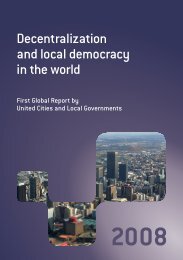Making Cities Resilient Report 2012
Making Cities Resilient Report 2012
Making Cities Resilient Report 2012
Create successful ePaper yourself
Turn your PDF publications into a flip-book with our unique Google optimized e-Paper software.
CHAPTER 4 | What are local governments doing to build resilience<br />
WHAT ARE LOCAL GOVERNMENTS DOING TO BUILD RESILIENCE<br />
This chapter presents many examples of resilience-building activities that cities and local governments<br />
are undertaking for each of the Ten Essentials for making cities resilient. It also points out gaps in areas<br />
that require further work to ensure more effective disaster risk reduction.<br />
1. Institutional and administrative<br />
framework for risk reduction<br />
Essential 1: Put in place organisation and coordination to understand and reduce disaster risk, based<br />
on participation of citizen groups and civil society. Build local alliances. Ensure that all departments<br />
understand their role in disaster risk reduction and preparedness.<br />
The Campaign and the Hyogo Framework for Action (HFA) emphasize the need for all city and town<br />
governments to have an institutional basis for implementing risk reduction that is multi-sectoral and<br />
involves all relevant stakeholders. Some Campaign cities have created municipal-level institutions to<br />
coordinate disaster risk and climate change, bringing together the functions and expertise of existing<br />
government departments to address hazard risks. In some countries, national frameworks and laws<br />
have helped create or strengthen municipal-level institutions. City governments are also engaging with<br />
a wide range of stakeholders beyond government departments, including multilateral and bilateral<br />
organisations, universities and research organisations that offer technical support, the private sector,<br />
NGOs and community organisations.<br />
City and local-level institutional structures<br />
City and regional governments are creating councils, committees, authorities, agencies, and other local<br />
disaster risk management institutions. In some cities, the mandate of existing bodies has been expanded<br />
beyond the scope of emergency preparedness and response to include disaster risk, climate change and<br />
resilience. In doing so, cities have also brought together government departments from across sectors or<br />
regions to collaborate on risk reduction. The institutional frameworks also include defining responsibilities<br />
for each government department. In Bhubaneswar, the city government has expanded its focus on postdisaster<br />
response to include disaster risk management, setting up institutions at the city and ward level<br />
to address disaster risk 6 .<br />
Strategies to institutionalise risk reduction and disaster management have been most effective where<br />
individuals or departments within local governments are legally responsible for implementation and<br />
coordination among all relevant departments or sectors. <strong>Cities</strong> in the Philippines have gone beyond a<br />
coordinating structure at the city level to institutionalise a community-scale structure for disaster risk<br />
management. In Makati City, a Barangay Disaster Risk Reduction and Management Committee acts as the<br />
implementing arm at community level of the Makati City Disaster Risk Reduction and Management Council;<br />
a similar structure is in place in Quezon City. San Francisco, Cebu has effectively empowered a dormant<br />
Purok structure for community development and disaster risk management (Puroks are one level below<br />
the Barangays and form the lowest level of informal governance (see Box 3.1). In Albay Province, a key<br />
practice for improving risk reduction was the redefining of functional roles and responsibilities of different<br />
institutions and task units. The Province has had a central coordinating office for disaster preparedness,<br />
response and recovery since 1994. This has now been joined with a technical secretariat to create the<br />
Albay Province Safety and Emergency Management Office (APSEMO), which has initiated many innovative<br />
approaches to tackling disaster risk and climate change.<br />
6. This has included a constitution for a ward-level disaster management committee, the formation of a disaster management team and<br />
preparation of the city disater managment plan. Forty-seven wards have prepared such plans (14, 16, 32)<br />
<strong>Making</strong> <strong>Cities</strong> <strong>Resilient</strong> <strong>Report</strong> <strong>2012</strong> | 39

















